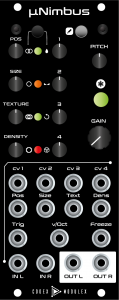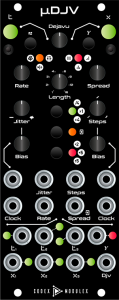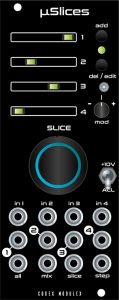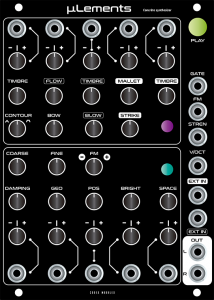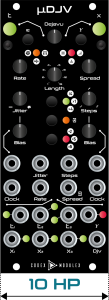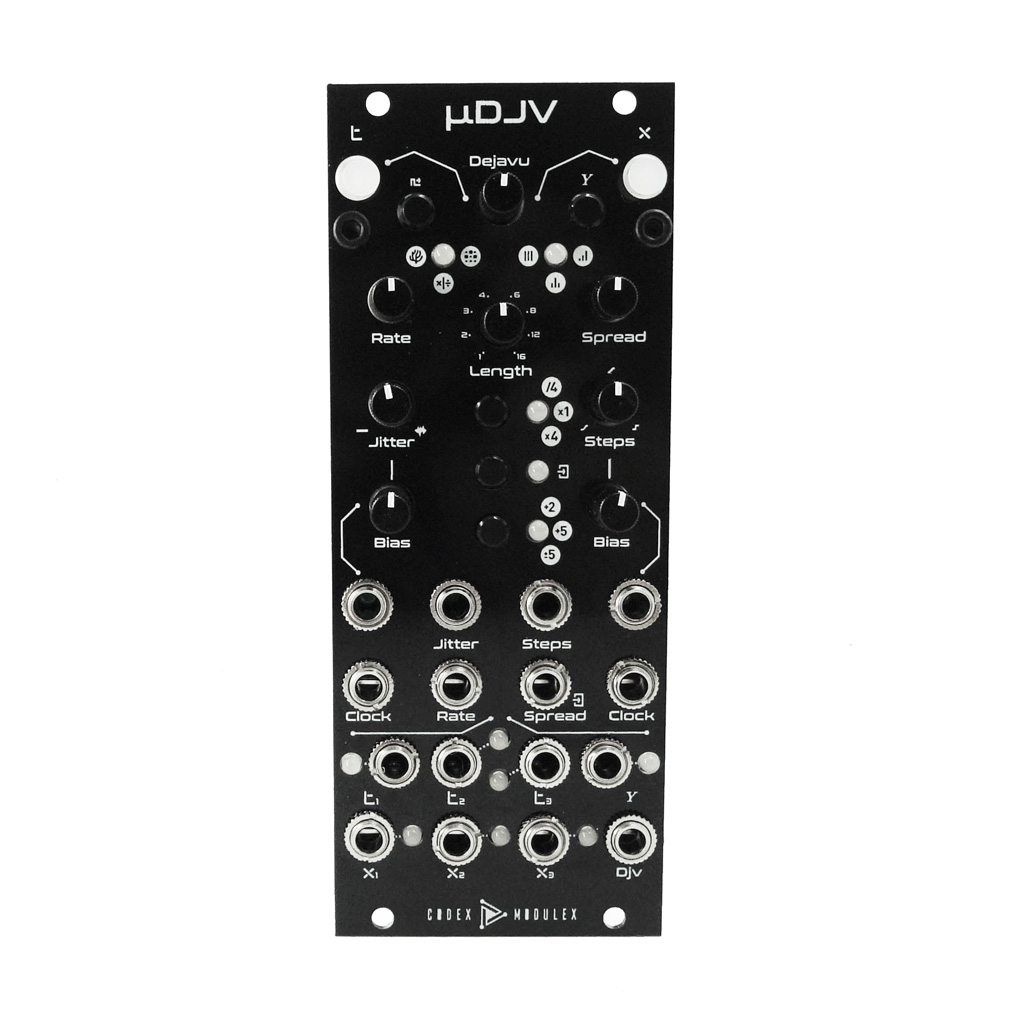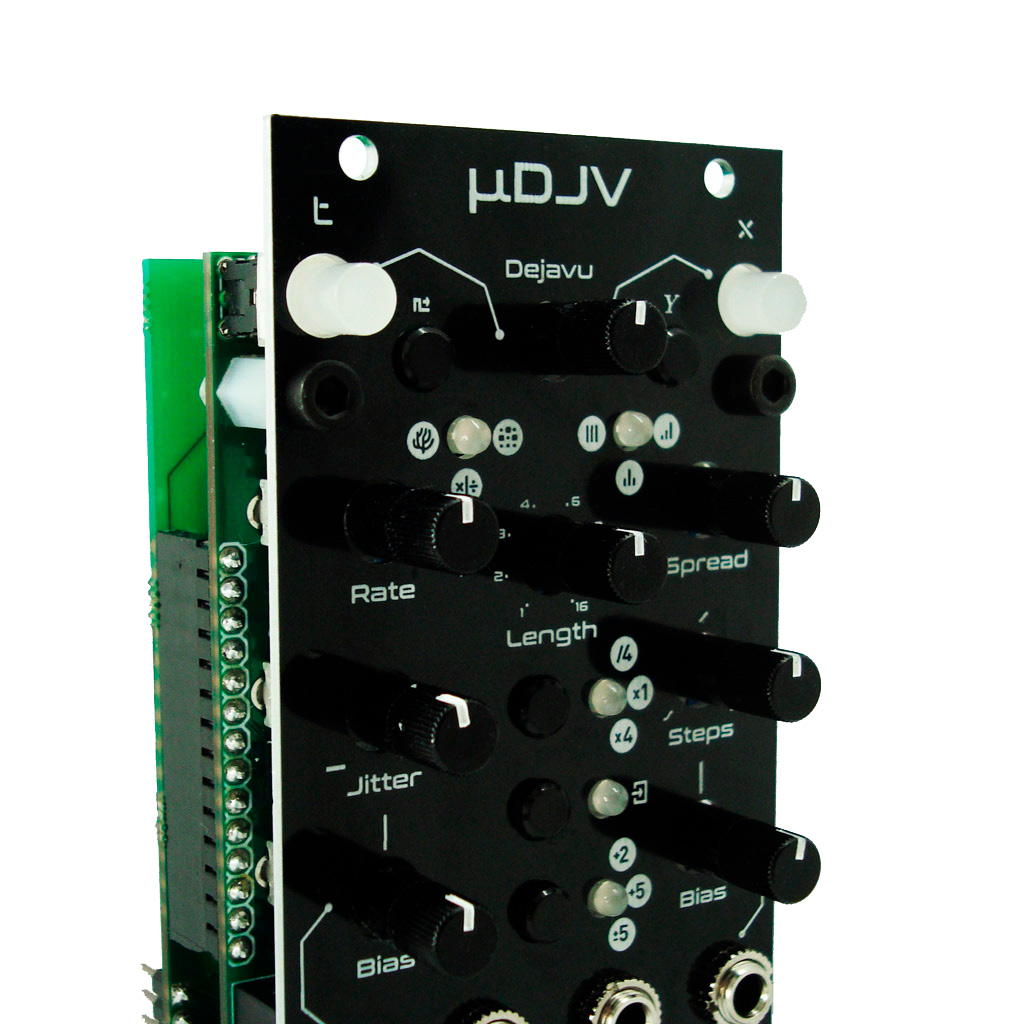uDJV
Random sampler
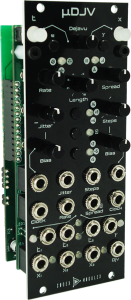
µDJV IS A SMALL FORMAT ADAPTATION OF THE ORIGINAL MUTABLE INSTRUMENTS “Marbles” MODULE
µDJV IS PRE-FLASHED WITH LAST OFFICIAL FIRMWARE AND FACTORY CALIBRATED
µDJV USES THE SAME CIRCUIT DESIGN AS THE ORIGINAL BUT IMPLEMENTED INTO ONLY 10 HP
Random gate generator
Master clock
- Internal clock with adjustable rate (with V/O CV input), or division/multiplication of an external clock.
- Range selection button further multiplying or dividing the clock by 4.
- Rhythm follower/predictor to lock onto uneven clock divisions or rhythmic patterns.
- Adjustable jitter (knob and CV), going from perfect tracking to completely erroneous – but always preserving the overall tempo.
Two-channel random rhythm generator
- Three gate outputs: t2 is the main output carrying the jittery clock, t1 and t3 are the complementary random rhythm output.
- Three generative models, with CV-controlled bias parameter increasing the density of notes on one channel or the other:
- Random routing of each clock pulse to either outputs, following a coin toss.
- Selection of a random division factor for one output, and the reciprocal factor for the other.
- Generation of random kick/snare patterns using a process similar to µSteps
- Adjustable gate duration, from short triggers to full length. Gate duration can be randomized.
Random voltage generator
- 3 outputs, either clocked by the 3 outputs of the random gate generator, or by a common external clock.
- Distribution control: SPREAD control, scanning between constant, bell-shaped, uniform or discrete distributions; and BIAS control biasing the generated voltage towards the bottom or top of the voltage range.
- Adjustable range: 0 to +2V (for melodies), 0 to +5V, -5V to +5V.
Quantized or smooth… CV Post-processor
- The STEPS parameter controls the steppiness/quantization of the output voltages.
- Turn this knob clockwise and a progressive quantizer is applied to the voltages – progressively reducing the probability of hitting a note outside of the scale, then making accidentals less likely, then giving more weight to the root and fifth – and at the extreme yielding only octaves.
- If steppy is not your thing, turn counterclockwise to increasingly slew the output voltages to the point that the module produces smooth, continuous curves.
Programmable quantizer
- 6 programmable scales.
- Scales are programmed by playing a short jam in the target scale: µDJV learns which notes are more prominent than others.
Output diversity
- The three outputs can all follow the settings dialed on the control panel, or react in different and opposite ways. The turn of a knob can completely push your patch towards a new direction!
Random looping and shuffling
- DEJA VU parameter increasing the probably of re-playing past material to the point that the generated output forms a loop… then increasing the probability of randomizing the order of this loop.
- The DEJA VU control applies to the random rhythm, the random voltages, or to both, or neither of them.
- Adjustable loop length from 1 to 16 steps.
External CV processing
- An external CV can be recorded in the DEJA VU loop in place of internal random voltages.
- All transformations performed by the random voltage generator (looping, shuffling, spreading, transposition, quantization, lag-processing) can be performed on external voltages.
- TLDR: live remixing of external sequences!
Specifications
- Analog random source.
- All inputs: 100k impedance, DC to 3.2kHz.
- Maximum input clock rate: 1kHz for the t Section, 8kHz for the X section.
- 32kHz refresh rate.
- 14-bit DAC with accurate software calibration – error below 1mV.
- 12-bit CV capture.
- Output levels: -5V to +5V for CVs (largest setting), 0V to +8V for gates.
- Input CV range: -5V to +5V.
Width: 8 HP
Deep: 35 mm
+12V: 80 mA
-12V: 20 mA
Original Marbles designed by Olivier Gillet of Mutable Instruments.







